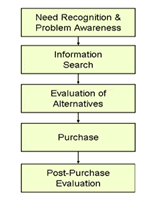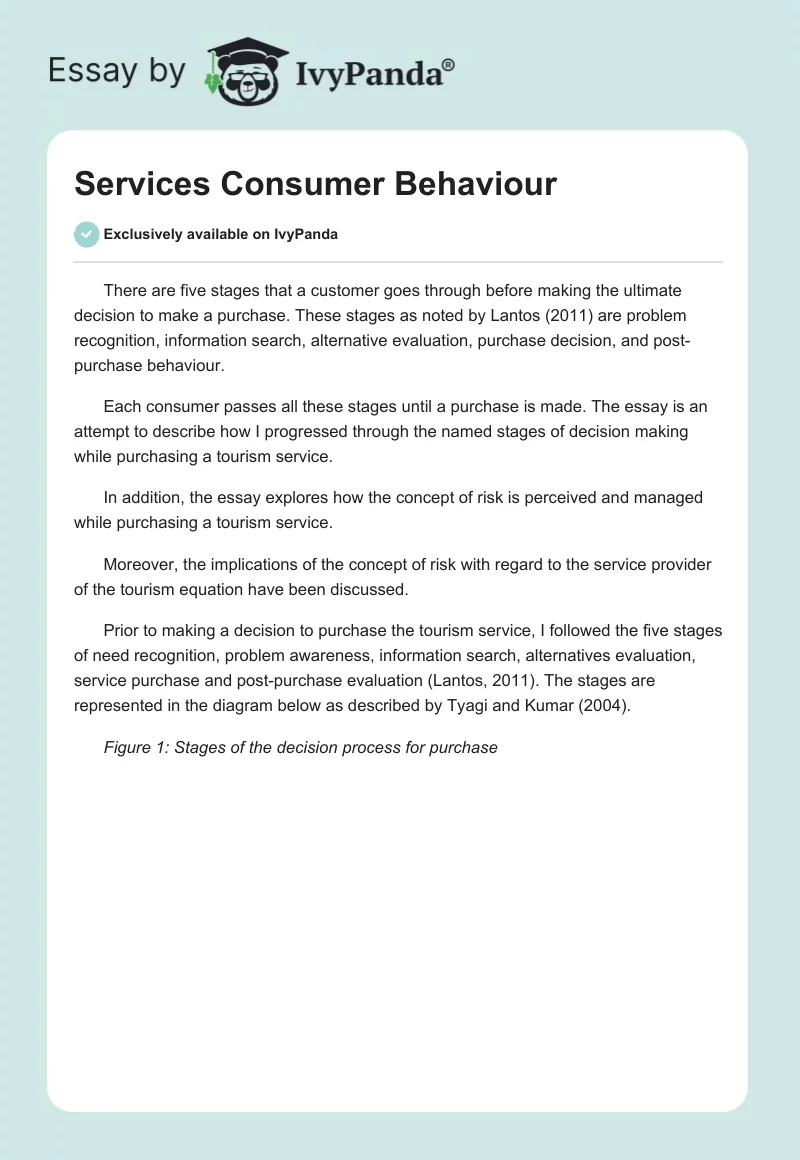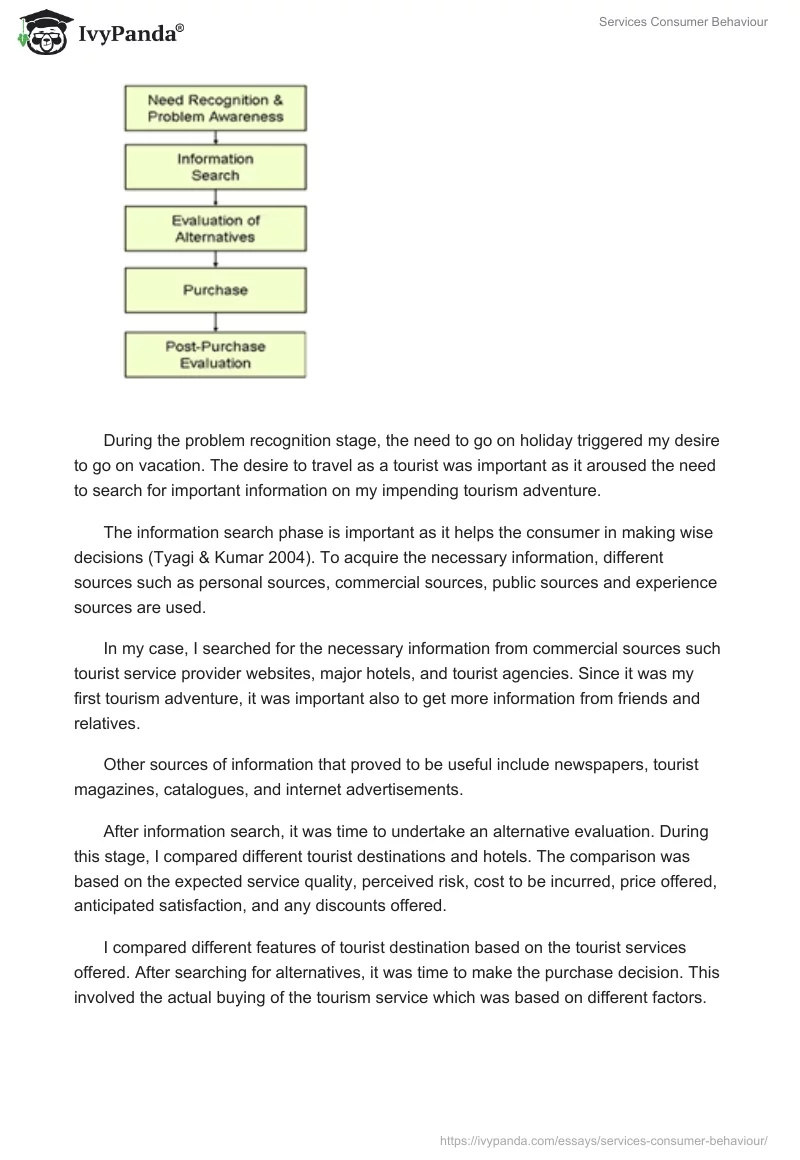There are five stages that a customer goes through before making the ultimate decision to make a purchase. These stages as noted by Lantos (2011) are problem recognition, information search, alternative evaluation, purchase decision, and post-purchase behaviour.
Each consumer passes all these stages until a purchase is made. The essay is an attempt to describe how I progressed through the named stages of decision making while purchasing a tourism service.
In addition, the essay explores how the concept of risk is perceived and managed while purchasing a tourism service.
Moreover, the implications of the concept of risk with regard to the service provider of the tourism equation have been discussed.
Prior to making a decision to purchase the tourism service, I followed the five stages of need recognition, problem awareness, information search, alternatives evaluation, service purchase and post-purchase evaluation (Lantos, 2011). The stages are represented in the diagram below as described by Tyagi and Kumar (2004).
Figure 1: Stages of the decision process for purchase

During the problem recognition stage, the need to go on holiday triggered my desire to go on vacation. The desire to travel as a tourist was important as it aroused the need to search for important information on my impending tourism adventure.
The information search phase is important as it helps the consumer in making wise decisions (Tyagi & Kumar 2004). To acquire the necessary information, different sources such as personal sources, commercial sources, public sources and experience sources are used.
In my case, I searched for the necessary information from commercial sources such tourist service provider websites, major hotels, and tourist agencies. Since it was my first tourism adventure, it was important also to get more information from friends and relatives.
Other sources of information that proved to be useful include newspapers, tourist magazines, catalogues, and internet advertisements.
After information search, it was time to undertake an alternative evaluation. During this stage, I compared different tourist destinations and hotels. The comparison was based on the expected service quality, perceived risk, cost to be incurred, price offered, anticipated satisfaction, and any discounts offered.
I compared different features of tourist destination based on the tourist services offered. After searching for alternatives, it was time to make the purchase decision. This involved the actual buying of the tourism service which was based on different factors.
Some of the factors that I had to take into account during the purchase of the service include the opinions of family and friends, recommendations and perceptions, available income, services offered by tourist agencies, and discounts offered.
The final stage involved in service purchase decision making was post-purchase behaviour (Lantos 2011). In this stage, consumers experience concerns after the purchase decision has been made based on cognitive dissonance (Tyagi & Kumar 2004).
During this stage, I experienced mixed reactions on whether I had made the right decisions in purchasing the tourism service.
To my consolation, the market of the tourism service pointed out that I had made the right decision as regards the purchase. After this experience, I can now recommend the service that I purchased to others.
How Concept of ‘risk’ is perceived and managed
Perceived risk can be described as the level of uncertainty while making a purchase decision relative to the outcome realized (Mitchell 1999). As a tourist, the concept of risk played an important role in the purchase decision making process.
Given that it was my first time to undertake a tourism service purchase, the level of risk perception was very high. According to Dickson and Dolnicar (2004), perception of risk is very high among consumers especially in the tourism industry.
In addition, risks perceived are influenced by social cultural aspects like demographics and level of income. In my case, family recommendations played an important role in reducing the perceived risks.
During the purchase, the perceived risk was related to price, anticipated satisfaction and value for money. The question of whether the decision made is the right one always arises during the decision making process.
Based on the rational choice theory, all consumers make rational decisions to maximize on purchased services or product. With respect to my tourism purchase, all potential risks were evaluated to achieve maximum satisfaction from the purchase.
Perceived risk is managed through the use of available information on a particular service or product (Cunningham Gerlach, & Harper 2004). This is normally high in service marketing because unlike products, services are intangible.
As noted by Cunningham, Gerlach, and Harper (2004), availability of information on the services provided helps in the management of perceived risks.
With respect to the purchase, availability of adequate information on the tourism service purchased reduced the perceived risks. In addition, information from friends and relatives reduced the perceived risks and aided in the decision making process.
Availability of information through adverts and other media outlets aids the consumer in making a purchase decision without postponing (Cunningham et al. 2004).
In the second and third stages, a consumer relies on personal recommendations and any available information that can reduce the perceived risk before a purchase is made.
The aforementioned factors played an important role in managing perceived risks while I made decisions related to the purchase.
Implications risk hold for service providers in tourism / hospitality
Perceived risks hold some implications to the suppliers of tourism services. For instance, high levels of risk perception by consumers reduce the number of sales made by tourism providers.
As noted by Dickson and Dolnicar (2004), risks play an integral role in the tourism industry since they enable service providers to offer the best services.
In addition, risks enable service providers in the supply side of tourism and hospitality equation design high valuable brands which increase the level of trust (Mitchell, 1999).
The higher the perceived risk of a certain product or service the lower the chance of the consumer purchasing that product or service. This affects the sales volumes of the product or service in question.
Cunningham, Gerlach, and Harper (2004) opine that “an extremely high level of perceived risk can cause a consumer to postpone or avoid a purchase entirely” (p. 23).
This means that if a consumer perceives the risk associated with a particular service will be high, and the consumer has the likelihood of postponing or avoiding the purchase.
With respect to the service providers in hospitality or tourism sector high risk would make consumers avoid or postpone a purchase.
Avoiding or postponing a purchase reduces the level of service sales and market share. In addition it exposes service providers to losses and low level of income.
Conclusion
The decision making process while purchasing a product or service entails different stages namely; need recognition and problem awareness, information search, alternatives evaluation, service purchase ad post-purchase evaluation.
Perceived risk is important as it assists the consumer to make effective decisions in order to maximize utility and achieve the anticipated satisfaction. Risk perception is managed through information search from multiple sources.
In addition, personal recommendations assist consumers manage perceived risk in second and third stages. High level of risk reduces sales as it makes consumer avoid a purchase or postpone it.
Reference List
Cunningham, D F, Gerlach, J & Harper, M D, 2004, ‘Assessing perceived risk of consumers in internet airline reservations services’, Journal of Air Transportation, vol. 9, no.1, pp. 21-35.
Dickson, T & Dolnicar, S, 2004. No risk, no fun – the role of perceived risk in adventure tourism. Sydney, University of Wollongong Press.
Lantos, G P 2011, Consumer behavior in action: real-life applications for marketing managers, Sharpe, Armonk.
Mitchell, V, 1999, ‘Consumer perceived risk: Conceptualisations and models’, European Journal of Marketing, vol. 33, no. 1/2, pp. 163-195
Tyagi, C L & Kumar, A 2004. Consumer behavior, Atlantic, New Delhi.


